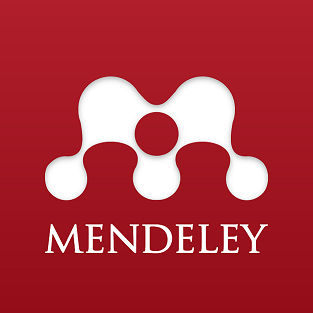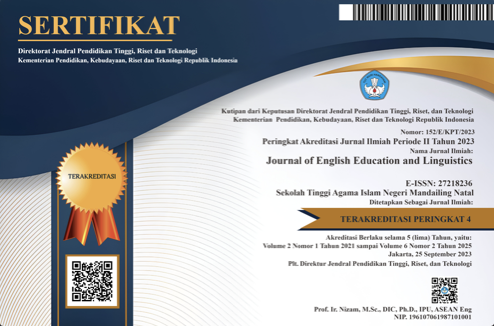THE ENGLISH LITERACY DEVELOPMENT AT ISLAMIC HIGH SCHOOLS: AN EVALUATION
DOI:
https://doi.org/10.56874/jeel.v4i2.1560Keywords:
English literacy, Development , Islamic High School.Abstract
English literacy is a captivating topic among language scholars, educators, and learners. English literacy culture in Indonesian schools still has been in dismaying condition. This study aimed to unveil hindrances and relevant solutions to realize the English literacy atmosphere at three state Islamic senior high schools (Madrasah Aliyah Negeri) in Sumatera Utara. Observation, in-depth interviews, and documentation were swiftly executed during the data collection process. Participants, consisting of five English teachers from three different State Islamic senior high schools, were willingly recruited to be interviewees. The data afterward were analyzed based on thematic analysis. Results highlighted two factors decelerating the English literacy environment at schools. Moreover, six crucial ways were unmasked for accelerating English literacy at school into positive progress.
References
Adawiyah, R. (2023). A Narrative Inquiry of Student’s English Speech Learning Experience through YouTube. Proceedings.Uinsaizu.Ac.Id, 600–613. https://proceedings.uinsaizu.ac.id/index.php/celti/article/view/536
Amalia, R., & Taufiq, M. A. (2023). Cultural Literacy in Academic-Related Documents of English Subject in Junior High School Sadar Budaya di Dokumen Akademik Pelajaran Bahasa Inggris di Sekolah Menengah Pertama. Lingua Didaktika, 17(1), 1–15. https://doi.org/10.24036/ld.v17i1.1
Anwas, E. O. M., Afriansyah, A., Iftitah, K. N., Firdaus, W., Sugiarti, Y., Sopandi, E., & Hediana, D. (2022). Students’ Literacy Skills and Quality of Textbooks in Indonesian Elementary Schools. International Journal of Language Education, 6(3), 233–244. https://doi.org/10.26858/ijole.v6i3.32756
Brown, H. D. (2004). Language Assesment: Principles and Classroom Practice. Pearson Education Inc.
Cabiles, R. C. (2023). THE EFFECTS OF COLLABORATIVE GAMES IN TEACHING ENGLISH LANGUAGE TO STUDENTS Roldan C. Cabiles. 4(1), 11–19. https://jurnal.stain-madina.ac.id/index.php/je2l/article/view/1196/980
Creswell, J. W., & Creswell, J. D. (2017). Research design: Qualitative, quantitative, and mixed methods approaches. In Journal of Reproductive Health (Vol. 2, Issue 3). Sage Publication,Inc.
Darojat, S. Q. (2022). Exploring the English literacy program in Indonesian Junior High School context : EFL teacher’s and students’ perceptions [UIN Sunan Gunung Djati Bandung]. https://etheses.uinsgd.ac.id/63285/
EF EPI. (2021). Daftar peringkat terbesar berdasarkan kemampuan bahasa Inggris di negara dan wilayah terbesar dunia. https://www.ef.co.id/epi/
Emzir. (2015). Metodologi penelitian pendidikan : kuantitatif dan kualitatif. Jakarta : Rajawali Pers.
Hardiana, N. D., Aisyah, N., & Harahap, N. H. (2023). the Effect of School Facilities on Students’ Learning Motivation on English. ANGLO-SAXON: Jurnal Ilmiah Program Studi Pendidikan Bahasa Inggris, 13(2). https://doi.org/10.33373/as.v13i2.4855
Hill, S. (2006). Developing Early Literacy: Assessment and Teaching. VIC: Eleanor Curtain Publishing.
Maharani, D., & Triastuti, A. (2023). School Literacy Program : A Lesson Learned From English Language Teaching At A Senior High School. International Scientific Journals of Social, Education, Humanities, 2(1). https://jurnal-stiepari.ac.id/index.php/LITERACY/article/view/531
Malau, J., Sigiro, M., Pardede, H., Munthe, B., & Sinurat, B. (2022). Peningkatan Literasi Bahasa Inggris ( Story Telling) Di SDN Pamah Melalui Kampus Mengajar Angkatan 3. Buguh: Jurnal Pengabdian Kepada Masyarakat, 2(4), 100–105. https://doi.org/10.23960/buguh.v2n4.1218
Miraj, A. A., Anis, M. A. R., Hasan, M. K., Shamem, A. S. M., & Monir, M. (2015). The Role of Vocabulary in English Language Teaching and Learning in Higher Secondary Education Level. Journal of Science and Technology, 5(1), 9–16.
Mohammed, A. (2017). The Role of Language Laboratory in English Language Learning Settings. English Language Teaching, 10(2), 86. https://doi.org/10.5539/elt.v10n2p86
Montoya, S. (2018). Defining Literacy. UNESCO, (Issued October).
Muharromah, I. A., & Mahmud, L. H. (2023). Upaya peningkatan literasi bahasa inggris dalam memahami struktur teks narasi di smk al ghozali bogor 1,2. 4(1), 492–499. http://www.openjournal.unpam.ac.id/index.php/Senan/article/view/32417
Muthmainnah, N. (2013). English Corner” A Setting To Support Clt Success Enhancing Students’ Speaking Skill [IAIN Ponorogo]. In NBER Working Papers. http://etheses.iainponorogo.ac.id
Nurfalah, R. S., & Pupah, E. M. (2022). English language teacher’s roles as viewed by EFL students. Englie: English Learning Innovation, 3(2). https://ejournal.umm.ac.id/index.php/englie/article/view/22135
Prayuda S, J. (2023). Factors Influencing Students’ Fears in The English Conversation Class. Journal of English Education and Linguistics, 4(1), 1–10. https://jurnal.stain-madina.ac.id/index.php/je2l/article/view/1195/979
Puspitasari, P. I., Padmadewi, N. N., & Dewi, L. P. E. S. (2021). Various English Literacy Activities in Bilingual Primary School. International Journal of Elementary Education, 5(1), 48. https://doi.org/10.23887/ijee.v5i1.31550
Sayekti, O. M., Khoirudin, I., & Yi Ying, C. (2023). The Effect of Family Literacy on Students’ Interest in Reading. Jurnal Prima Edukasia, 11(1), 131–141. https://doi.org/10.21831/jpe.v11i1.56261
Tambunsaribu, G., & Galingging, Y. (2021). Masalah Yang Dihadapi Pelajar Bahasa Inggris Dalam Memahami Pelajaran Bahasa Inggris. Dialektika: Jurnal Bahasa, Sastra Dan Budaya, 8(1), 30–41. https://doi.org/10.33541/dia.v8i1.3110
Wei, C., Kao, H., LU, H., & Liu, Y. (2018). The Effects of Competitive Gaming Scenarios and Personalized Assistance Strategies on English Vocabulary Learning. Journal of Educational Technology & Society, 21(3), 146–158. http://www.jstor.org/stable/26458514
Downloads
Published
Issue
Section
License
All articles published in the Journal of English Education and Linguistics are licensed under a Creative Commons Attribution-ShareAlike 4.0 International (CC BY-SA) license. This means anyone is free to copy, transform, or redistribute articles for any lawful purpose in any medium, provided they give appropriate attribution to the original author(s) and Journal of English Education and Linguistics, link to the license, indicate if changes were made, and redistribute any derivative work under the same license.
Copyright on articles is retained by the respective author(s) without restrictions. A non-exclusive license is granted to the Journal of English Education and Linguistics to publish the article and identify itself as its original publisher, along with the commercial right to include the article in a hardcopy issue for sale to libraries and individuals.
Although the conditions of the Creative Commons Attribution-ShareAlike 4.0 International (CC BY-SA) license do not apply to authors (as the copyright holder of your article, you have no restrictions on your rights), by submitting to the Journal of English Education and Linguistics, authors recognize the rights of readers and must grant any third party the right to use their articles to the extent provided by the license.

This work is licensed under a Creative Commons Attribution-ShareAlike 4.0 International License.








